Poundland Retail: Analysis of Decision Making Process and Strategies
VerifiedAdded on 2019/12/04
|20
|5677
|133
Report
AI Summary
This report examines the decision-making process within Poundland retail, focusing on improving strategies for business growth. It analyzes the importance of information and knowledge management, differentiating between data, information, and knowledge. The report assesses internal and external sources of information, identifies stakeholders, and explores effective communication methods. It also suggests strategies for improving communication, stakeholder involvement, and information access, including the use of IT systems and feedback mechanisms. The report highlights the importance of strategic, tactical, and operational decisions, emphasizing the need for a comprehensive approach to enhance sales and overall organizational effectiveness. It covers methods for communicating with stakeholders, involving them in decision-making processes, and designing strategies for continuous improvement within the company.
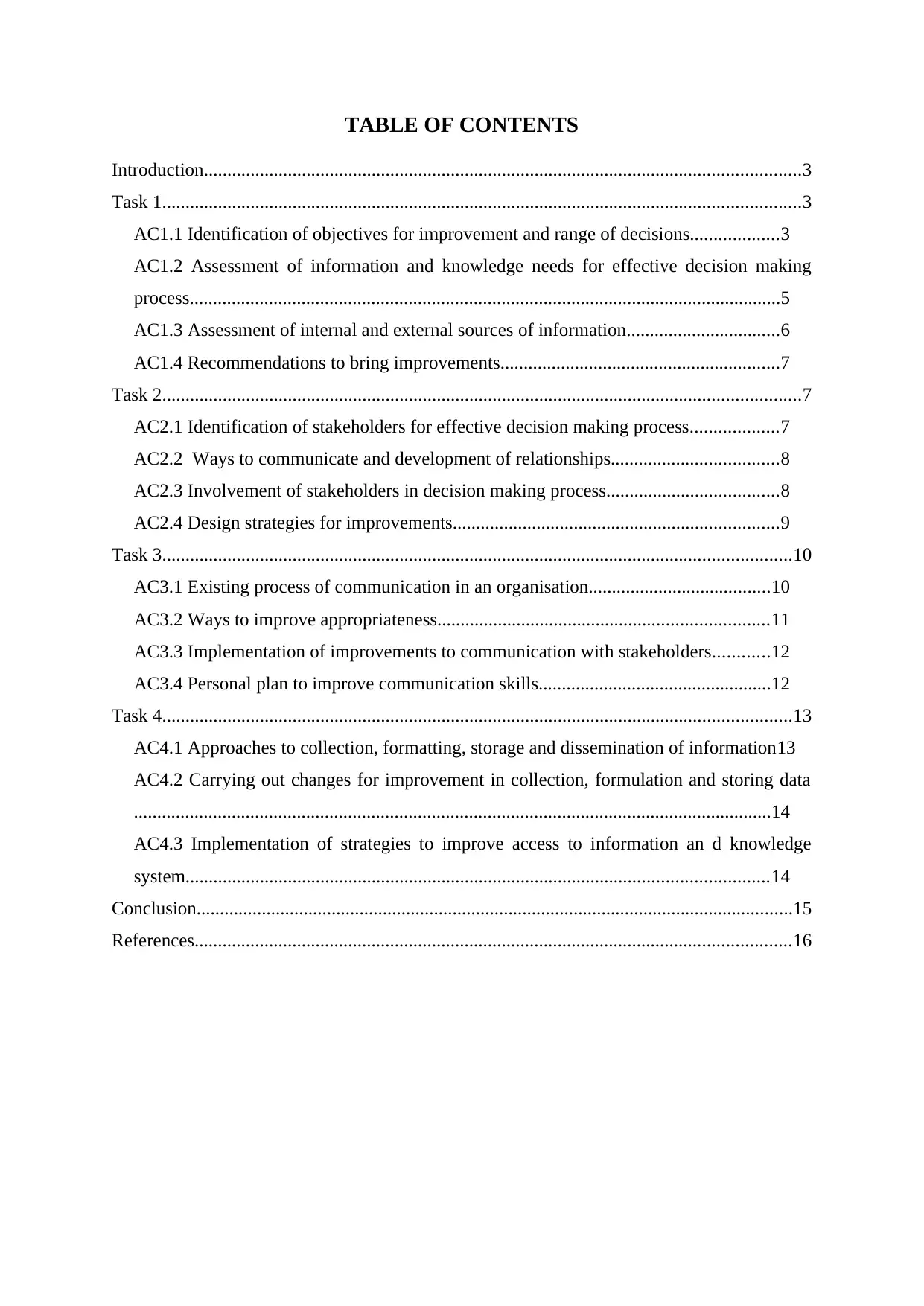
TABLE OF CONTENTS
Introduction................................................................................................................................3
Task 1.........................................................................................................................................3
AC1.1 Identification of objectives for improvement and range of decisions...................3
AC1.2 Assessment of information and knowledge needs for effective decision making
process...............................................................................................................................5
AC1.3 Assessment of internal and external sources of information.................................6
AC1.4 Recommendations to bring improvements............................................................7
Task 2.........................................................................................................................................7
AC2.1 Identification of stakeholders for effective decision making process...................7
AC2.2 Ways to communicate and development of relationships....................................8
AC2.3 Involvement of stakeholders in decision making process.....................................8
AC2.4 Design strategies for improvements......................................................................9
Task 3.......................................................................................................................................10
AC3.1 Existing process of communication in an organisation.......................................10
AC3.2 Ways to improve appropriateness.......................................................................11
AC3.3 Implementation of improvements to communication with stakeholders............12
AC3.4 Personal plan to improve communication skills..................................................12
Task 4.......................................................................................................................................13
AC4.1 Approaches to collection, formatting, storage and dissemination of information13
AC4.2 Carrying out changes for improvement in collection, formulation and storing data
.........................................................................................................................................14
AC4.3 Implementation of strategies to improve access to information an d knowledge
system.............................................................................................................................14
Conclusion................................................................................................................................15
References................................................................................................................................16
Introduction................................................................................................................................3
Task 1.........................................................................................................................................3
AC1.1 Identification of objectives for improvement and range of decisions...................3
AC1.2 Assessment of information and knowledge needs for effective decision making
process...............................................................................................................................5
AC1.3 Assessment of internal and external sources of information.................................6
AC1.4 Recommendations to bring improvements............................................................7
Task 2.........................................................................................................................................7
AC2.1 Identification of stakeholders for effective decision making process...................7
AC2.2 Ways to communicate and development of relationships....................................8
AC2.3 Involvement of stakeholders in decision making process.....................................8
AC2.4 Design strategies for improvements......................................................................9
Task 3.......................................................................................................................................10
AC3.1 Existing process of communication in an organisation.......................................10
AC3.2 Ways to improve appropriateness.......................................................................11
AC3.3 Implementation of improvements to communication with stakeholders............12
AC3.4 Personal plan to improve communication skills..................................................12
Task 4.......................................................................................................................................13
AC4.1 Approaches to collection, formatting, storage and dissemination of information13
AC4.2 Carrying out changes for improvement in collection, formulation and storing data
.........................................................................................................................................14
AC4.3 Implementation of strategies to improve access to information an d knowledge
system.............................................................................................................................14
Conclusion................................................................................................................................15
References................................................................................................................................16
Paraphrase This Document
Need a fresh take? Get an instant paraphrase of this document with our AI Paraphraser
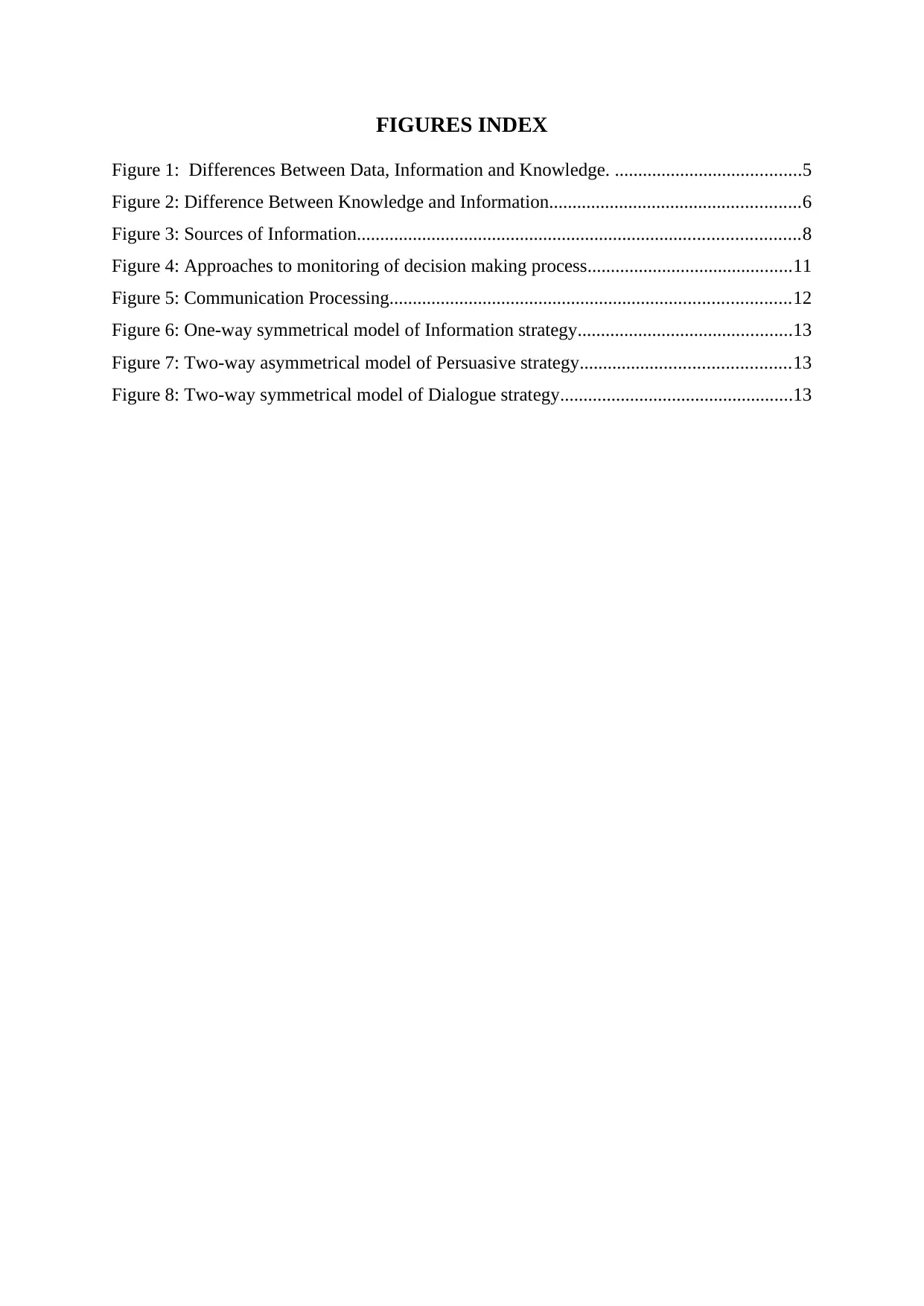
FIGURES INDEX
Figure 1: Differences Between Data, Information and Knowledge. ........................................5
Figure 2: Difference Between Knowledge and Information......................................................6
Figure 3: Sources of Information...............................................................................................8
Figure 4: Approaches to monitoring of decision making process............................................11
Figure 5: Communication Processing......................................................................................12
Figure 6: One-way symmetrical model of Information strategy..............................................13
Figure 7: Two-way asymmetrical model of Persuasive strategy.............................................13
Figure 8: Two-way symmetrical model of Dialogue strategy..................................................13
Figure 1: Differences Between Data, Information and Knowledge. ........................................5
Figure 2: Difference Between Knowledge and Information......................................................6
Figure 3: Sources of Information...............................................................................................8
Figure 4: Approaches to monitoring of decision making process............................................11
Figure 5: Communication Processing......................................................................................12
Figure 6: One-way symmetrical model of Information strategy..............................................13
Figure 7: Two-way asymmetrical model of Persuasive strategy.............................................13
Figure 8: Two-way symmetrical model of Dialogue strategy..................................................13
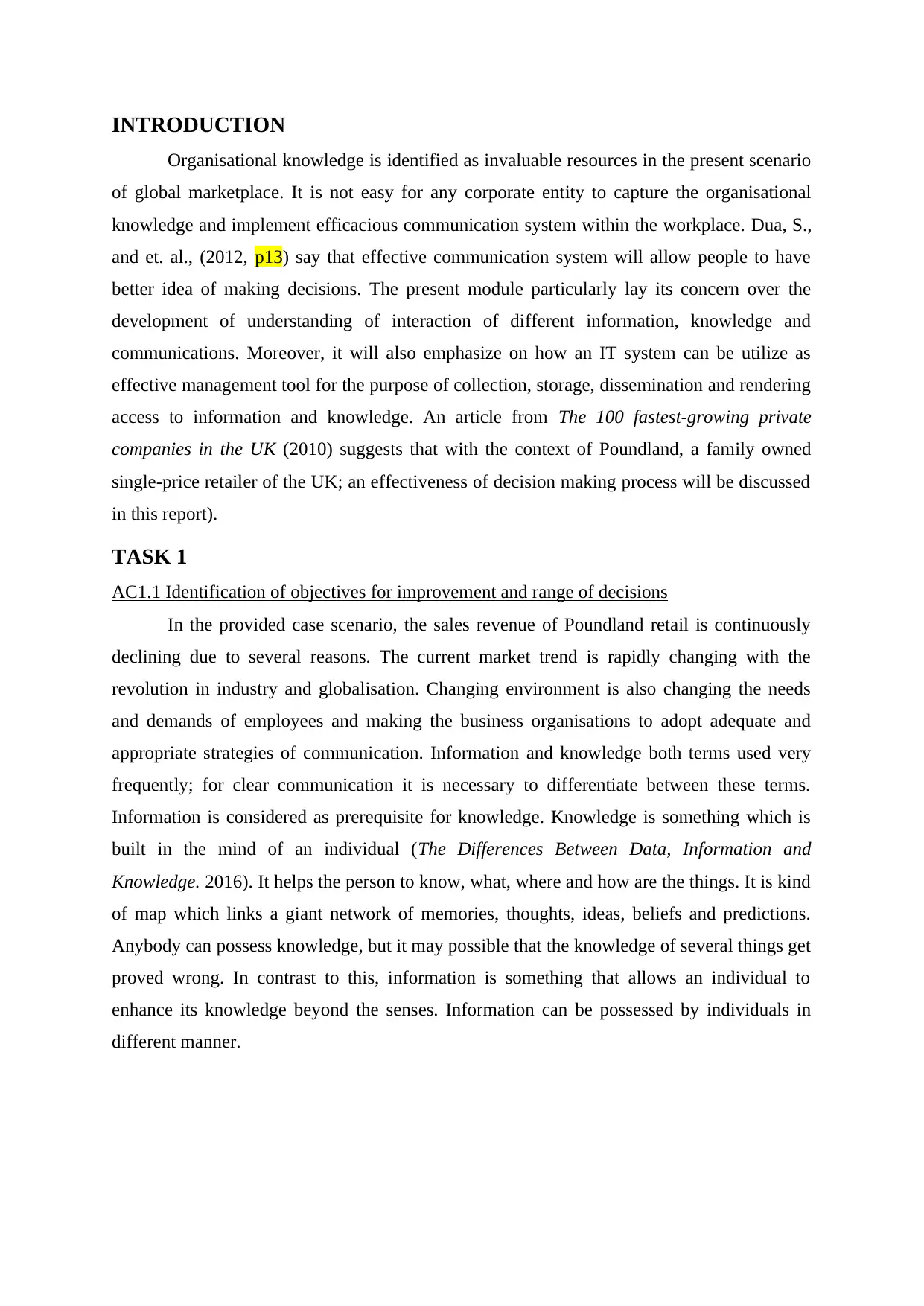
INTRODUCTION
Organisational knowledge is identified as invaluable resources in the present scenario
of global marketplace. It is not easy for any corporate entity to capture the organisational
knowledge and implement efficacious communication system within the workplace. Dua, S.,
and et. al., (2012, p13) say that effective communication system will allow people to have
better idea of making decisions. The present module particularly lay its concern over the
development of understanding of interaction of different information, knowledge and
communications. Moreover, it will also emphasize on how an IT system can be utilize as
effective management tool for the purpose of collection, storage, dissemination and rendering
access to information and knowledge. An article from The 100 fastest-growing private
companies in the UK (2010) suggests that with the context of Poundland, a family owned
single-price retailer of the UK; an effectiveness of decision making process will be discussed
in this report).
TASK 1
AC1.1 Identification of objectives for improvement and range of decisions
In the provided case scenario, the sales revenue of Poundland retail is continuously
declining due to several reasons. The current market trend is rapidly changing with the
revolution in industry and globalisation. Changing environment is also changing the needs
and demands of employees and making the business organisations to adopt adequate and
appropriate strategies of communication. Information and knowledge both terms used very
frequently; for clear communication it is necessary to differentiate between these terms.
Information is considered as prerequisite for knowledge. Knowledge is something which is
built in the mind of an individual (The Differences Between Data, Information and
Knowledge. 2016). It helps the person to know, what, where and how are the things. It is kind
of map which links a giant network of memories, thoughts, ideas, beliefs and predictions.
Anybody can possess knowledge, but it may possible that the knowledge of several things get
proved wrong. In contrast to this, information is something that allows an individual to
enhance its knowledge beyond the senses. Information can be possessed by individuals in
different manner.
Organisational knowledge is identified as invaluable resources in the present scenario
of global marketplace. It is not easy for any corporate entity to capture the organisational
knowledge and implement efficacious communication system within the workplace. Dua, S.,
and et. al., (2012, p13) say that effective communication system will allow people to have
better idea of making decisions. The present module particularly lay its concern over the
development of understanding of interaction of different information, knowledge and
communications. Moreover, it will also emphasize on how an IT system can be utilize as
effective management tool for the purpose of collection, storage, dissemination and rendering
access to information and knowledge. An article from The 100 fastest-growing private
companies in the UK (2010) suggests that with the context of Poundland, a family owned
single-price retailer of the UK; an effectiveness of decision making process will be discussed
in this report).
TASK 1
AC1.1 Identification of objectives for improvement and range of decisions
In the provided case scenario, the sales revenue of Poundland retail is continuously
declining due to several reasons. The current market trend is rapidly changing with the
revolution in industry and globalisation. Changing environment is also changing the needs
and demands of employees and making the business organisations to adopt adequate and
appropriate strategies of communication. Information and knowledge both terms used very
frequently; for clear communication it is necessary to differentiate between these terms.
Information is considered as prerequisite for knowledge. Knowledge is something which is
built in the mind of an individual (The Differences Between Data, Information and
Knowledge. 2016). It helps the person to know, what, where and how are the things. It is kind
of map which links a giant network of memories, thoughts, ideas, beliefs and predictions.
Anybody can possess knowledge, but it may possible that the knowledge of several things get
proved wrong. In contrast to this, information is something that allows an individual to
enhance its knowledge beyond the senses. Information can be possessed by individuals in
different manner.
⊘ This is a preview!⊘
Do you want full access?
Subscribe today to unlock all pages.

Trusted by 1+ million students worldwide
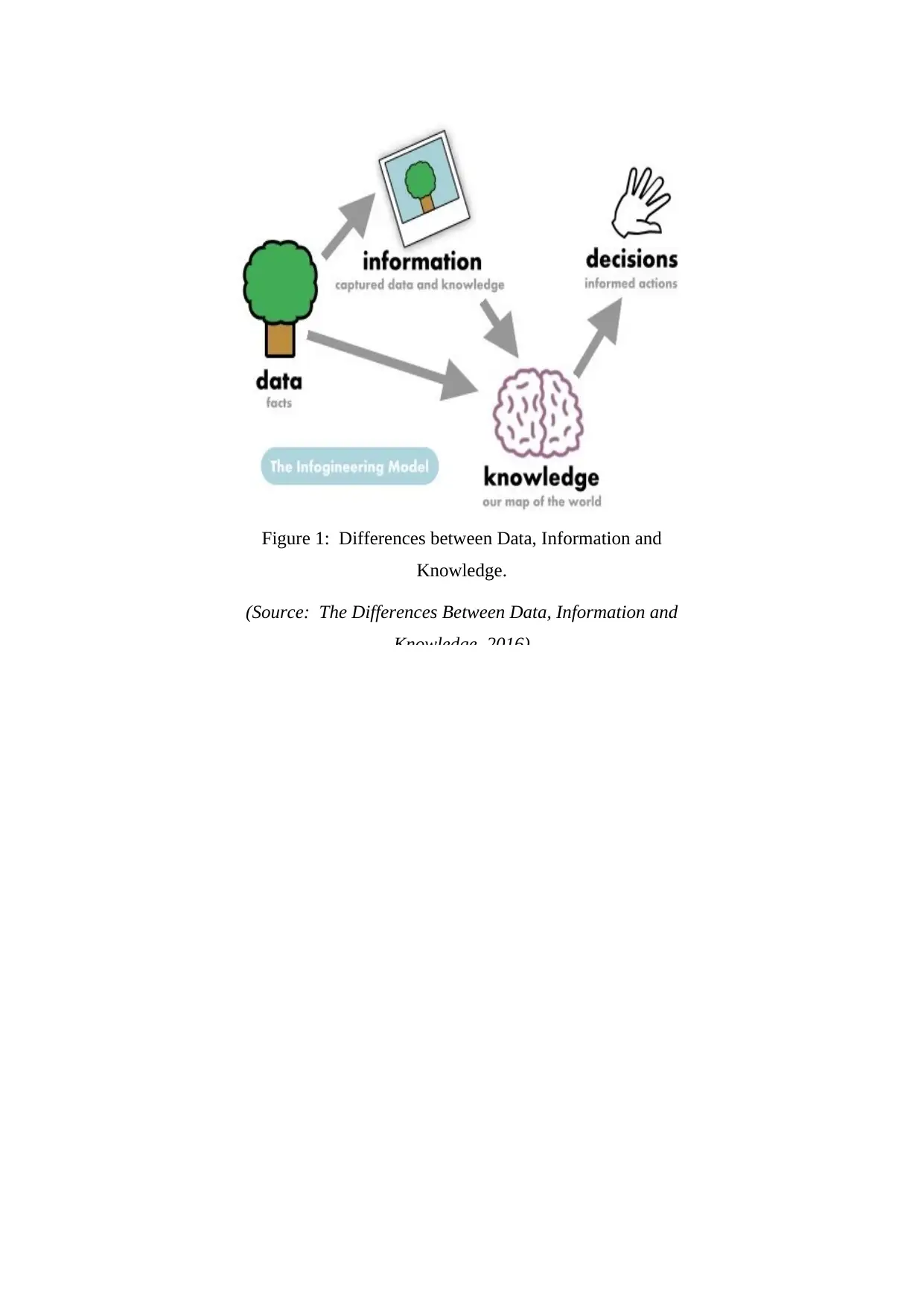
Figure 1: Differences between Data, Information and
Knowledge.
(Source: The Differences Between Data, Information and
Knowledge. 2016)
Knowledge.
(Source: The Differences Between Data, Information and
Knowledge. 2016)
Paraphrase This Document
Need a fresh take? Get an instant paraphrase of this document with our AI Paraphraser
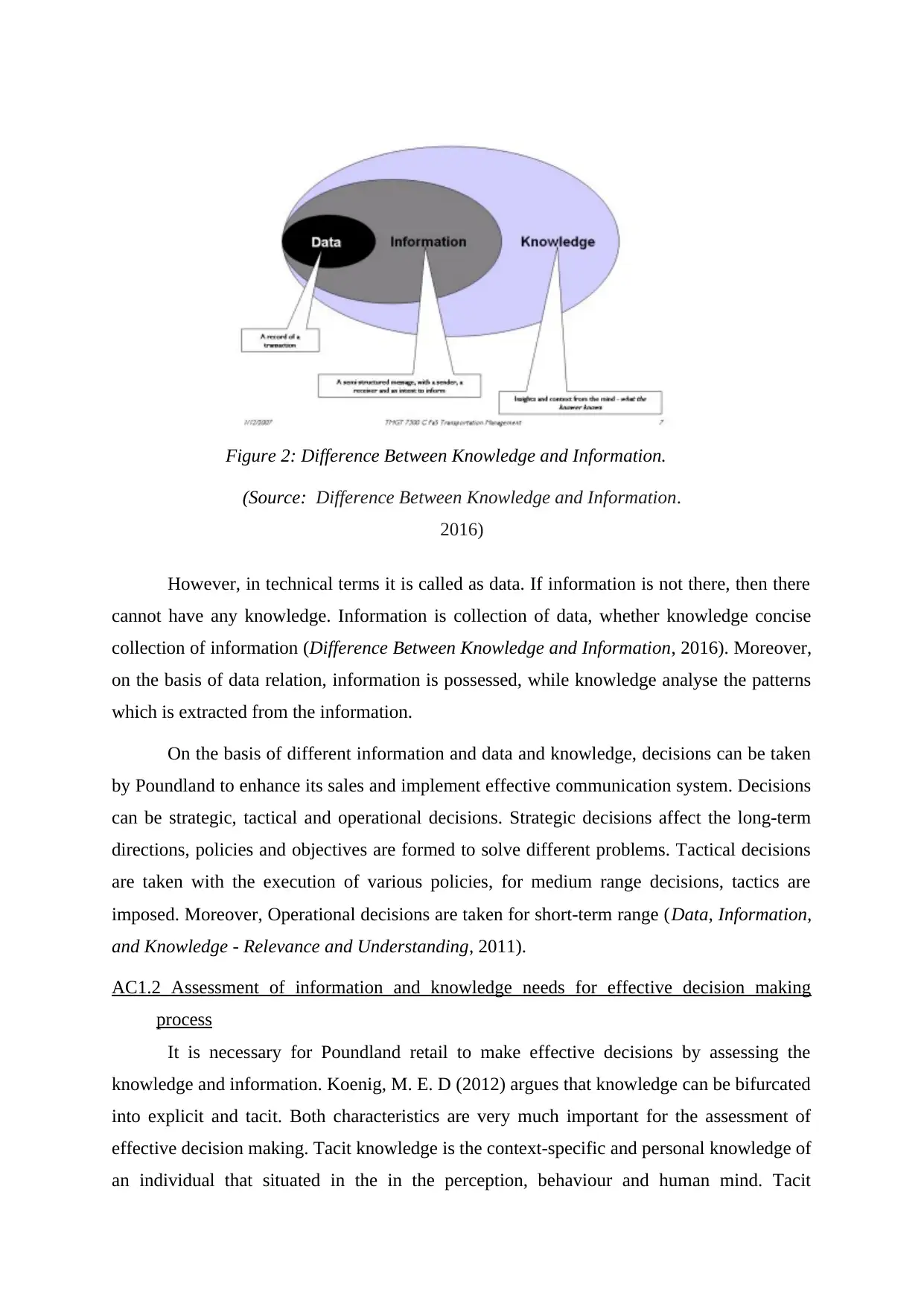
However, in technical terms it is called as data. If information is not there, then there
cannot have any knowledge. Information is collection of data, whether knowledge concise
collection of information (Difference Between Knowledge and Information, 2016). Moreover,
on the basis of data relation, information is possessed, while knowledge analyse the patterns
which is extracted from the information.
On the basis of different information and data and knowledge, decisions can be taken
by Poundland to enhance its sales and implement effective communication system. Decisions
can be strategic, tactical and operational decisions. Strategic decisions affect the long-term
directions, policies and objectives are formed to solve different problems. Tactical decisions
are taken with the execution of various policies, for medium range decisions, tactics are
imposed. Moreover, Operational decisions are taken for short-term range (Data, Information,
and Knowledge - Relevance and Understanding, 2011).
AC1.2 Assessment of information and knowledge needs for effective decision making
process
It is necessary for Poundland retail to make effective decisions by assessing the
knowledge and information. Koenig, M. E. D (2012) argues that knowledge can be bifurcated
into explicit and tacit. Both characteristics are very much important for the assessment of
effective decision making. Tacit knowledge is the context-specific and personal knowledge of
an individual that situated in the in the perception, behaviour and human mind. Tacit
Figure 2: Difference Between Knowledge and Information.
(Source: Difference Between Knowledge and Information.
2016)
cannot have any knowledge. Information is collection of data, whether knowledge concise
collection of information (Difference Between Knowledge and Information, 2016). Moreover,
on the basis of data relation, information is possessed, while knowledge analyse the patterns
which is extracted from the information.
On the basis of different information and data and knowledge, decisions can be taken
by Poundland to enhance its sales and implement effective communication system. Decisions
can be strategic, tactical and operational decisions. Strategic decisions affect the long-term
directions, policies and objectives are formed to solve different problems. Tactical decisions
are taken with the execution of various policies, for medium range decisions, tactics are
imposed. Moreover, Operational decisions are taken for short-term range (Data, Information,
and Knowledge - Relevance and Understanding, 2011).
AC1.2 Assessment of information and knowledge needs for effective decision making
process
It is necessary for Poundland retail to make effective decisions by assessing the
knowledge and information. Koenig, M. E. D (2012) argues that knowledge can be bifurcated
into explicit and tacit. Both characteristics are very much important for the assessment of
effective decision making. Tacit knowledge is the context-specific and personal knowledge of
an individual that situated in the in the perception, behaviour and human mind. Tacit
Figure 2: Difference Between Knowledge and Information.
(Source: Difference Between Knowledge and Information.
2016)
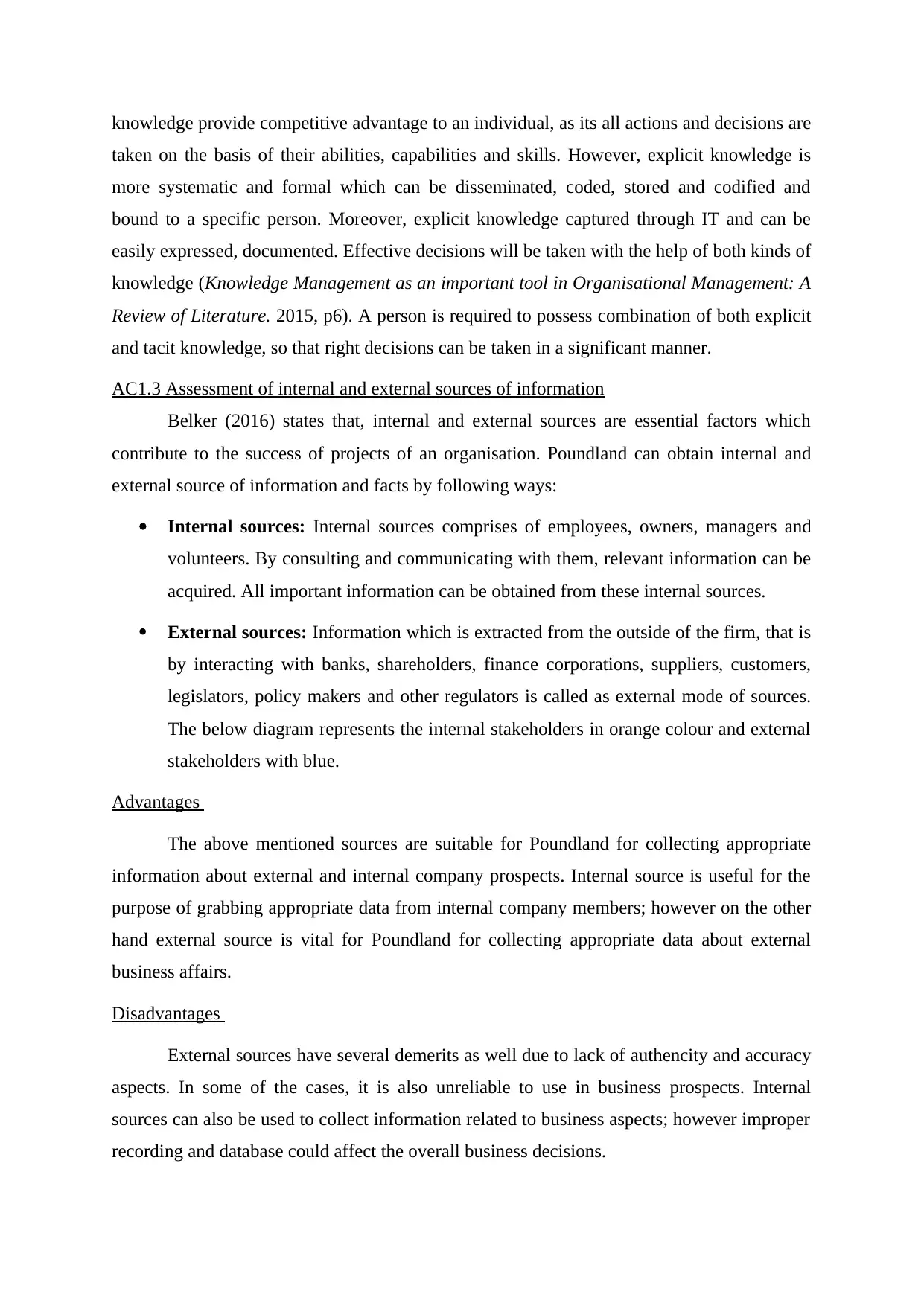
knowledge provide competitive advantage to an individual, as its all actions and decisions are
taken on the basis of their abilities, capabilities and skills. However, explicit knowledge is
more systematic and formal which can be disseminated, coded, stored and codified and
bound to a specific person. Moreover, explicit knowledge captured through IT and can be
easily expressed, documented. Effective decisions will be taken with the help of both kinds of
knowledge (Knowledge Management as an important tool in Organisational Management: A
Review of Literature. 2015, p6). A person is required to possess combination of both explicit
and tacit knowledge, so that right decisions can be taken in a significant manner.
AC1.3 Assessment of internal and external sources of information
Belker (2016) states that, internal and external sources are essential factors which
contribute to the success of projects of an organisation. Poundland can obtain internal and
external source of information and facts by following ways:
Internal sources: Internal sources comprises of employees, owners, managers and
volunteers. By consulting and communicating with them, relevant information can be
acquired. All important information can be obtained from these internal sources.
External sources: Information which is extracted from the outside of the firm, that is
by interacting with banks, shareholders, finance corporations, suppliers, customers,
legislators, policy makers and other regulators is called as external mode of sources.
The below diagram represents the internal stakeholders in orange colour and external
stakeholders with blue.
Advantages
The above mentioned sources are suitable for Poundland for collecting appropriate
information about external and internal company prospects. Internal source is useful for the
purpose of grabbing appropriate data from internal company members; however on the other
hand external source is vital for Poundland for collecting appropriate data about external
business affairs.
Disadvantages
External sources have several demerits as well due to lack of authencity and accuracy
aspects. In some of the cases, it is also unreliable to use in business prospects. Internal
sources can also be used to collect information related to business aspects; however improper
recording and database could affect the overall business decisions.
taken on the basis of their abilities, capabilities and skills. However, explicit knowledge is
more systematic and formal which can be disseminated, coded, stored and codified and
bound to a specific person. Moreover, explicit knowledge captured through IT and can be
easily expressed, documented. Effective decisions will be taken with the help of both kinds of
knowledge (Knowledge Management as an important tool in Organisational Management: A
Review of Literature. 2015, p6). A person is required to possess combination of both explicit
and tacit knowledge, so that right decisions can be taken in a significant manner.
AC1.3 Assessment of internal and external sources of information
Belker (2016) states that, internal and external sources are essential factors which
contribute to the success of projects of an organisation. Poundland can obtain internal and
external source of information and facts by following ways:
Internal sources: Internal sources comprises of employees, owners, managers and
volunteers. By consulting and communicating with them, relevant information can be
acquired. All important information can be obtained from these internal sources.
External sources: Information which is extracted from the outside of the firm, that is
by interacting with banks, shareholders, finance corporations, suppliers, customers,
legislators, policy makers and other regulators is called as external mode of sources.
The below diagram represents the internal stakeholders in orange colour and external
stakeholders with blue.
Advantages
The above mentioned sources are suitable for Poundland for collecting appropriate
information about external and internal company prospects. Internal source is useful for the
purpose of grabbing appropriate data from internal company members; however on the other
hand external source is vital for Poundland for collecting appropriate data about external
business affairs.
Disadvantages
External sources have several demerits as well due to lack of authencity and accuracy
aspects. In some of the cases, it is also unreliable to use in business prospects. Internal
sources can also be used to collect information related to business aspects; however improper
recording and database could affect the overall business decisions.
⊘ This is a preview!⊘
Do you want full access?
Subscribe today to unlock all pages.

Trusted by 1+ million students worldwide
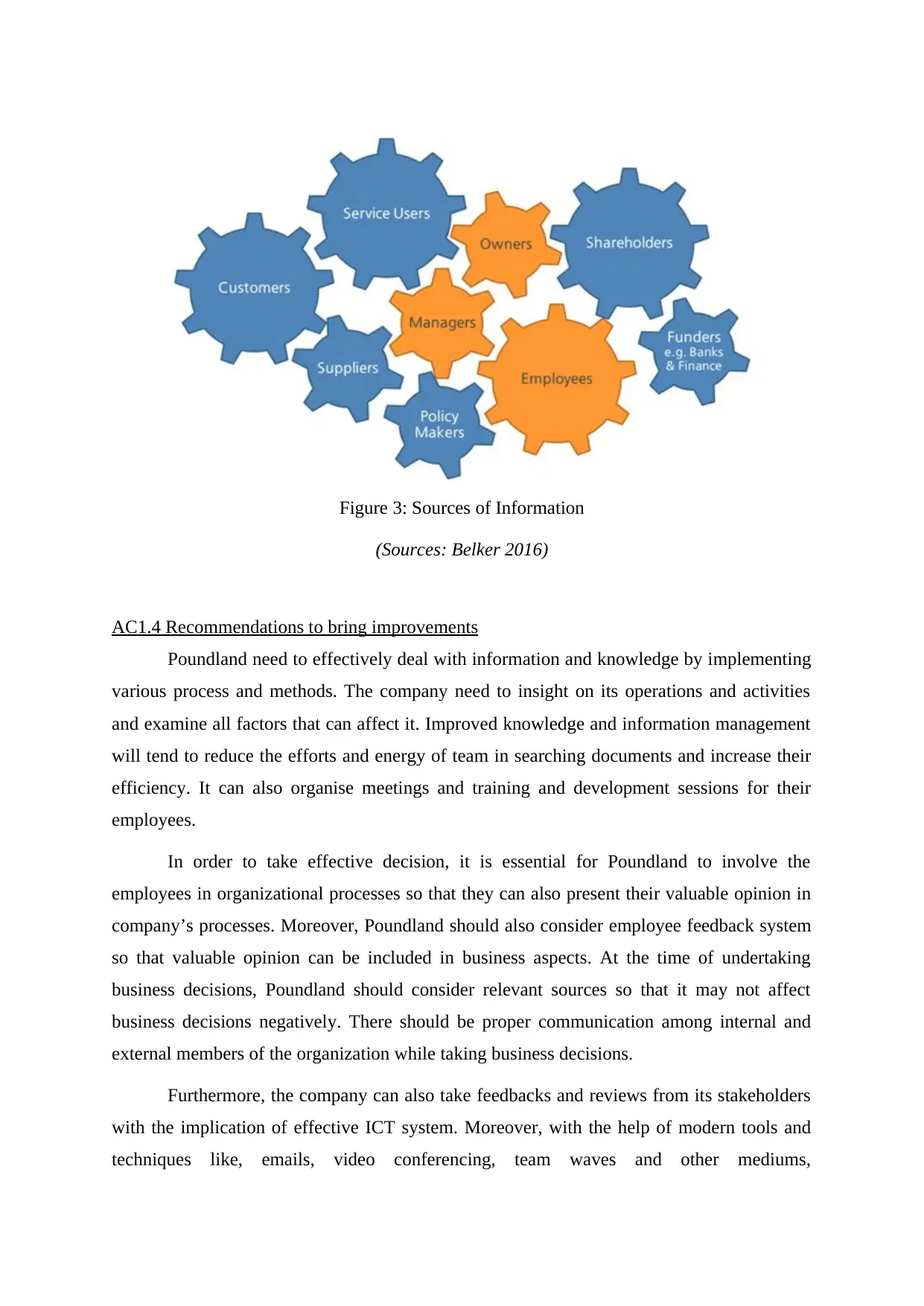
AC1.4 Recommendations to bring improvements
Poundland need to effectively deal with information and knowledge by implementing
various process and methods. The company need to insight on its operations and activities
and examine all factors that can affect it. Improved knowledge and information management
will tend to reduce the efforts and energy of team in searching documents and increase their
efficiency. It can also organise meetings and training and development sessions for their
employees.
In order to take effective decision, it is essential for Poundland to involve the
employees in organizational processes so that they can also present their valuable opinion in
company’s processes. Moreover, Poundland should also consider employee feedback system
so that valuable opinion can be included in business aspects. At the time of undertaking
business decisions, Poundland should consider relevant sources so that it may not affect
business decisions negatively. There should be proper communication among internal and
external members of the organization while taking business decisions.
Furthermore, the company can also take feedbacks and reviews from its stakeholders
with the implication of effective ICT system. Moreover, with the help of modern tools and
techniques like, emails, video conferencing, team waves and other mediums,
Figure 3: Sources of Information
(Sources: Belker 2016)
Poundland need to effectively deal with information and knowledge by implementing
various process and methods. The company need to insight on its operations and activities
and examine all factors that can affect it. Improved knowledge and information management
will tend to reduce the efforts and energy of team in searching documents and increase their
efficiency. It can also organise meetings and training and development sessions for their
employees.
In order to take effective decision, it is essential for Poundland to involve the
employees in organizational processes so that they can also present their valuable opinion in
company’s processes. Moreover, Poundland should also consider employee feedback system
so that valuable opinion can be included in business aspects. At the time of undertaking
business decisions, Poundland should consider relevant sources so that it may not affect
business decisions negatively. There should be proper communication among internal and
external members of the organization while taking business decisions.
Furthermore, the company can also take feedbacks and reviews from its stakeholders
with the implication of effective ICT system. Moreover, with the help of modern tools and
techniques like, emails, video conferencing, team waves and other mediums,
Figure 3: Sources of Information
(Sources: Belker 2016)
Paraphrase This Document
Need a fresh take? Get an instant paraphrase of this document with our AI Paraphraser
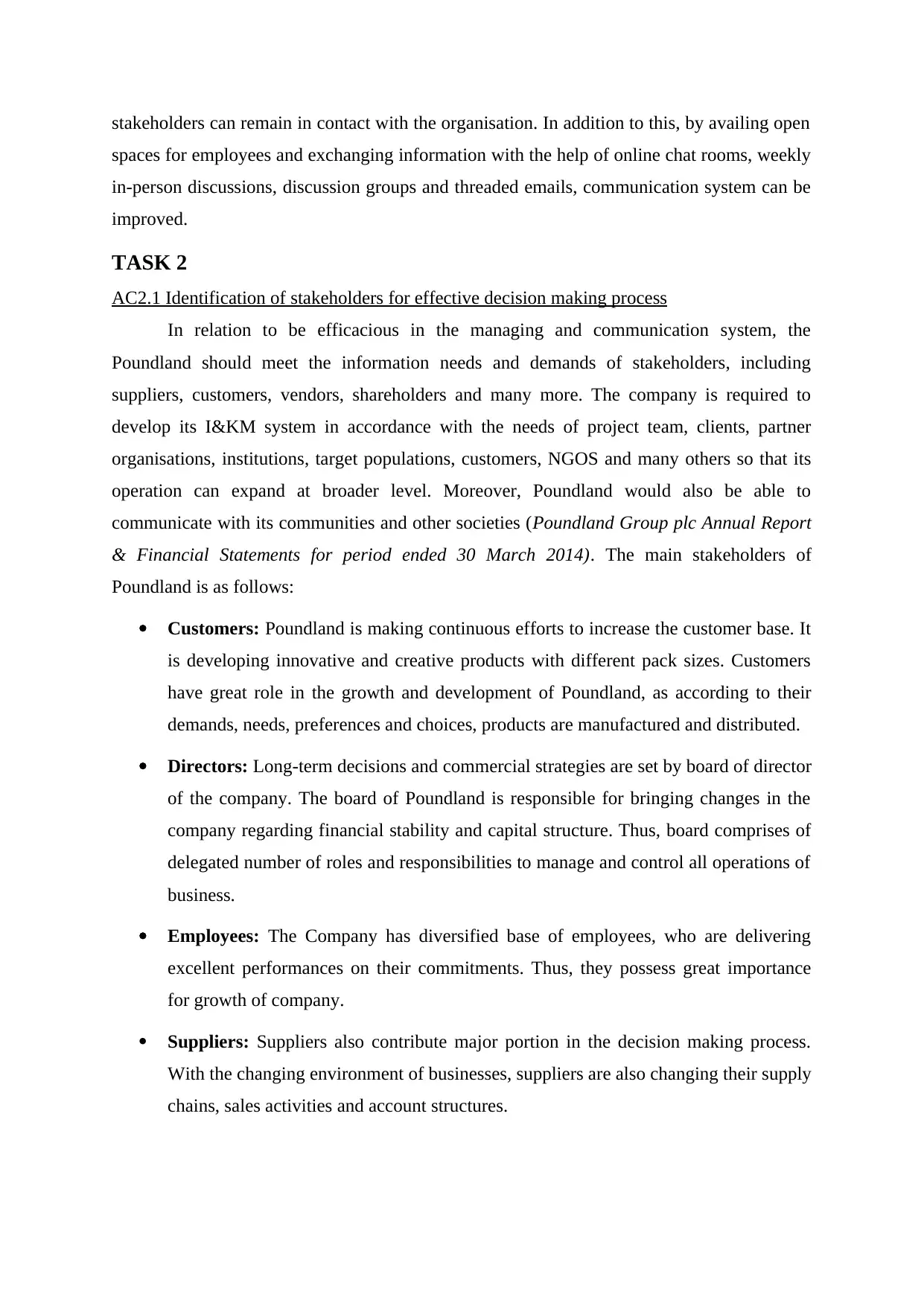
stakeholders can remain in contact with the organisation. In addition to this, by availing open
spaces for employees and exchanging information with the help of online chat rooms, weekly
in-person discussions, discussion groups and threaded emails, communication system can be
improved.
TASK 2
AC2.1 Identification of stakeholders for effective decision making process
In relation to be efficacious in the managing and communication system, the
Poundland should meet the information needs and demands of stakeholders, including
suppliers, customers, vendors, shareholders and many more. The company is required to
develop its I&KM system in accordance with the needs of project team, clients, partner
organisations, institutions, target populations, customers, NGOS and many others so that its
operation can expand at broader level. Moreover, Poundland would also be able to
communicate with its communities and other societies (Poundland Group plc Annual Report
& Financial Statements for period ended 30 March 2014). The main stakeholders of
Poundland is as follows:
Customers: Poundland is making continuous efforts to increase the customer base. It
is developing innovative and creative products with different pack sizes. Customers
have great role in the growth and development of Poundland, as according to their
demands, needs, preferences and choices, products are manufactured and distributed.
Directors: Long-term decisions and commercial strategies are set by board of director
of the company. The board of Poundland is responsible for bringing changes in the
company regarding financial stability and capital structure. Thus, board comprises of
delegated number of roles and responsibilities to manage and control all operations of
business.
Employees: The Company has diversified base of employees, who are delivering
excellent performances on their commitments. Thus, they possess great importance
for growth of company.
Suppliers: Suppliers also contribute major portion in the decision making process.
With the changing environment of businesses, suppliers are also changing their supply
chains, sales activities and account structures.
spaces for employees and exchanging information with the help of online chat rooms, weekly
in-person discussions, discussion groups and threaded emails, communication system can be
improved.
TASK 2
AC2.1 Identification of stakeholders for effective decision making process
In relation to be efficacious in the managing and communication system, the
Poundland should meet the information needs and demands of stakeholders, including
suppliers, customers, vendors, shareholders and many more. The company is required to
develop its I&KM system in accordance with the needs of project team, clients, partner
organisations, institutions, target populations, customers, NGOS and many others so that its
operation can expand at broader level. Moreover, Poundland would also be able to
communicate with its communities and other societies (Poundland Group plc Annual Report
& Financial Statements for period ended 30 March 2014). The main stakeholders of
Poundland is as follows:
Customers: Poundland is making continuous efforts to increase the customer base. It
is developing innovative and creative products with different pack sizes. Customers
have great role in the growth and development of Poundland, as according to their
demands, needs, preferences and choices, products are manufactured and distributed.
Directors: Long-term decisions and commercial strategies are set by board of director
of the company. The board of Poundland is responsible for bringing changes in the
company regarding financial stability and capital structure. Thus, board comprises of
delegated number of roles and responsibilities to manage and control all operations of
business.
Employees: The Company has diversified base of employees, who are delivering
excellent performances on their commitments. Thus, they possess great importance
for growth of company.
Suppliers: Suppliers also contribute major portion in the decision making process.
With the changing environment of businesses, suppliers are also changing their supply
chains, sales activities and account structures.
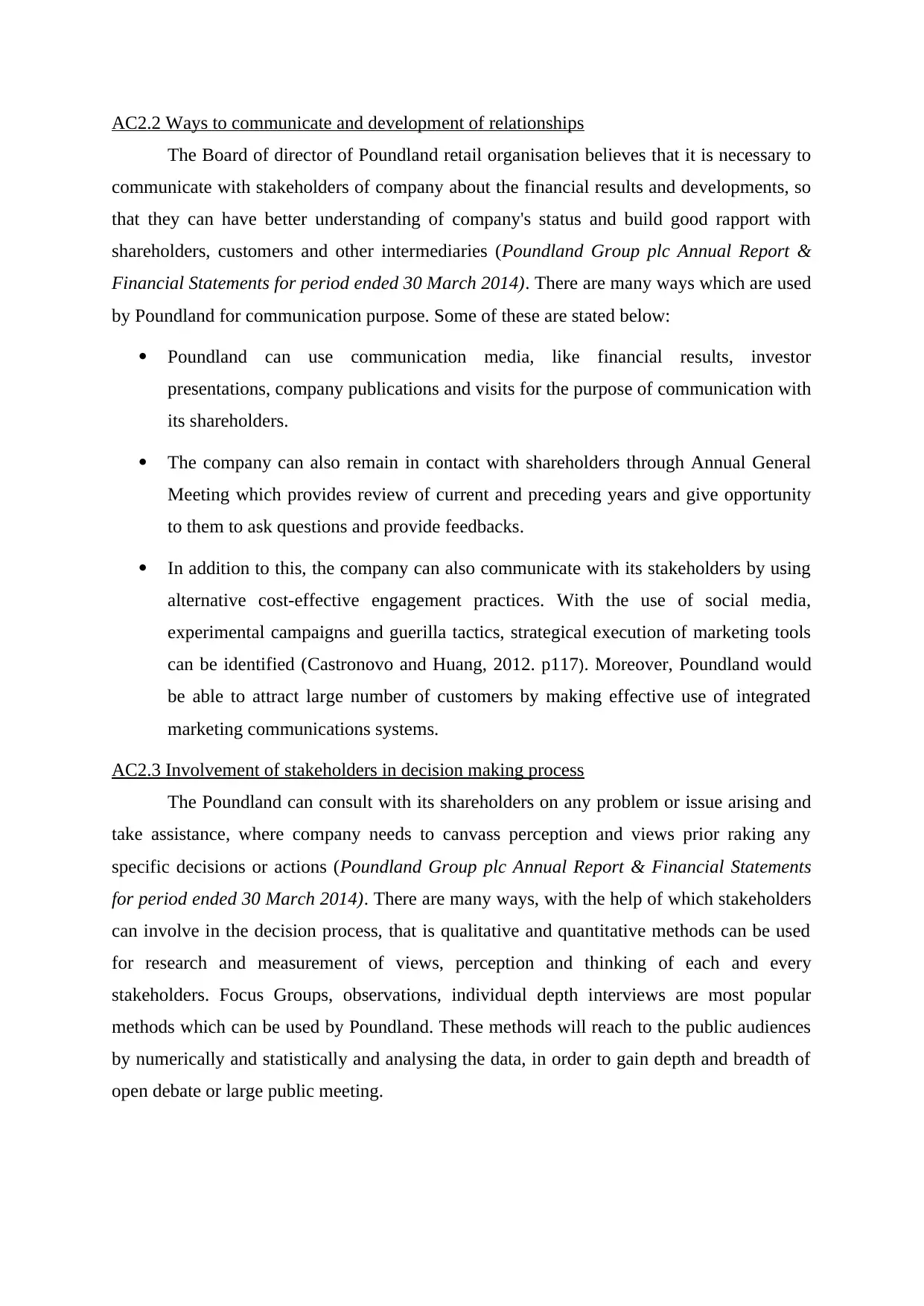
AC2.2 Ways to communicate and development of relationships
The Board of director of Poundland retail organisation believes that it is necessary to
communicate with stakeholders of company about the financial results and developments, so
that they can have better understanding of company's status and build good rapport with
shareholders, customers and other intermediaries (Poundland Group plc Annual Report &
Financial Statements for period ended 30 March 2014). There are many ways which are used
by Poundland for communication purpose. Some of these are stated below:
Poundland can use communication media, like financial results, investor
presentations, company publications and visits for the purpose of communication with
its shareholders.
The company can also remain in contact with shareholders through Annual General
Meeting which provides review of current and preceding years and give opportunity
to them to ask questions and provide feedbacks.
In addition to this, the company can also communicate with its stakeholders by using
alternative cost-effective engagement practices. With the use of social media,
experimental campaigns and guerilla tactics, strategical execution of marketing tools
can be identified (Castronovo and Huang, 2012. p117). Moreover, Poundland would
be able to attract large number of customers by making effective use of integrated
marketing communications systems.
AC2.3 Involvement of stakeholders in decision making process
The Poundland can consult with its shareholders on any problem or issue arising and
take assistance, where company needs to canvass perception and views prior raking any
specific decisions or actions (Poundland Group plc Annual Report & Financial Statements
for period ended 30 March 2014). There are many ways, with the help of which stakeholders
can involve in the decision process, that is qualitative and quantitative methods can be used
for research and measurement of views, perception and thinking of each and every
stakeholders. Focus Groups, observations, individual depth interviews are most popular
methods which can be used by Poundland. These methods will reach to the public audiences
by numerically and statistically and analysing the data, in order to gain depth and breadth of
open debate or large public meeting.
The Board of director of Poundland retail organisation believes that it is necessary to
communicate with stakeholders of company about the financial results and developments, so
that they can have better understanding of company's status and build good rapport with
shareholders, customers and other intermediaries (Poundland Group plc Annual Report &
Financial Statements for period ended 30 March 2014). There are many ways which are used
by Poundland for communication purpose. Some of these are stated below:
Poundland can use communication media, like financial results, investor
presentations, company publications and visits for the purpose of communication with
its shareholders.
The company can also remain in contact with shareholders through Annual General
Meeting which provides review of current and preceding years and give opportunity
to them to ask questions and provide feedbacks.
In addition to this, the company can also communicate with its stakeholders by using
alternative cost-effective engagement practices. With the use of social media,
experimental campaigns and guerilla tactics, strategical execution of marketing tools
can be identified (Castronovo and Huang, 2012. p117). Moreover, Poundland would
be able to attract large number of customers by making effective use of integrated
marketing communications systems.
AC2.3 Involvement of stakeholders in decision making process
The Poundland can consult with its shareholders on any problem or issue arising and
take assistance, where company needs to canvass perception and views prior raking any
specific decisions or actions (Poundland Group plc Annual Report & Financial Statements
for period ended 30 March 2014). There are many ways, with the help of which stakeholders
can involve in the decision process, that is qualitative and quantitative methods can be used
for research and measurement of views, perception and thinking of each and every
stakeholders. Focus Groups, observations, individual depth interviews are most popular
methods which can be used by Poundland. These methods will reach to the public audiences
by numerically and statistically and analysing the data, in order to gain depth and breadth of
open debate or large public meeting.
⊘ This is a preview!⊘
Do you want full access?
Subscribe today to unlock all pages.

Trusted by 1+ million students worldwide
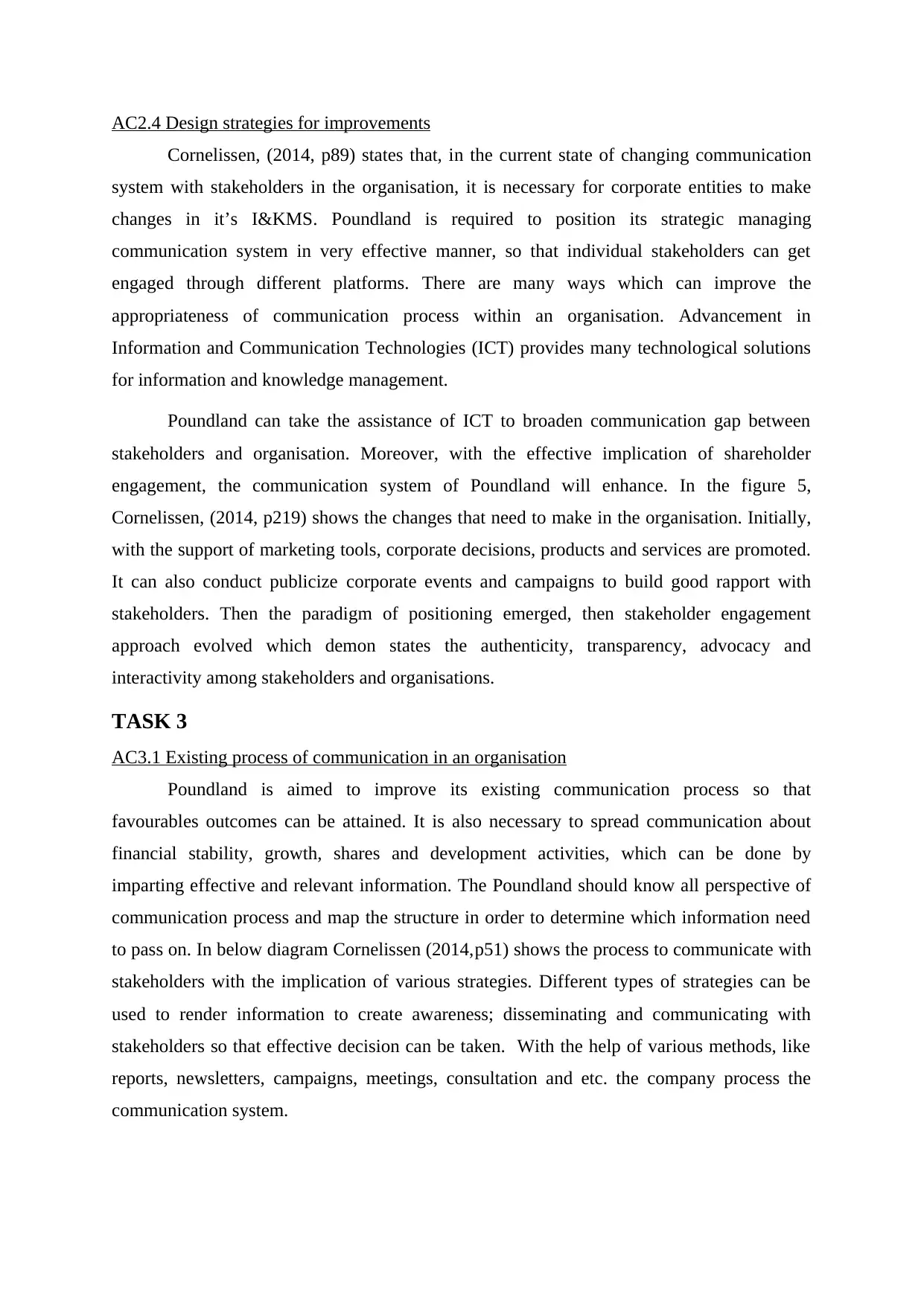
AC2.4 Design strategies for improvements
Cornelissen, (2014, p89) states that, in the current state of changing communication
system with stakeholders in the organisation, it is necessary for corporate entities to make
changes in it’s I&KMS. Poundland is required to position its strategic managing
communication system in very effective manner, so that individual stakeholders can get
engaged through different platforms. There are many ways which can improve the
appropriateness of communication process within an organisation. Advancement in
Information and Communication Technologies (ICT) provides many technological solutions
for information and knowledge management.
Poundland can take the assistance of ICT to broaden communication gap between
stakeholders and organisation. Moreover, with the effective implication of shareholder
engagement, the communication system of Poundland will enhance. In the figure 5,
Cornelissen, (2014, p219) shows the changes that need to make in the organisation. Initially,
with the support of marketing tools, corporate decisions, products and services are promoted.
It can also conduct publicize corporate events and campaigns to build good rapport with
stakeholders. Then the paradigm of positioning emerged, then stakeholder engagement
approach evolved which demon states the authenticity, transparency, advocacy and
interactivity among stakeholders and organisations.
TASK 3
AC3.1 Existing process of communication in an organisation
Poundland is aimed to improve its existing communication process so that
favourables outcomes can be attained. It is also necessary to spread communication about
financial stability, growth, shares and development activities, which can be done by
imparting effective and relevant information. The Poundland should know all perspective of
communication process and map the structure in order to determine which information need
to pass on. In below diagram Cornelissen (2014,p51) shows the process to communicate with
stakeholders with the implication of various strategies. Different types of strategies can be
used to render information to create awareness; disseminating and communicating with
stakeholders so that effective decision can be taken. With the help of various methods, like
reports, newsletters, campaigns, meetings, consultation and etc. the company process the
communication system.
Cornelissen, (2014, p89) states that, in the current state of changing communication
system with stakeholders in the organisation, it is necessary for corporate entities to make
changes in it’s I&KMS. Poundland is required to position its strategic managing
communication system in very effective manner, so that individual stakeholders can get
engaged through different platforms. There are many ways which can improve the
appropriateness of communication process within an organisation. Advancement in
Information and Communication Technologies (ICT) provides many technological solutions
for information and knowledge management.
Poundland can take the assistance of ICT to broaden communication gap between
stakeholders and organisation. Moreover, with the effective implication of shareholder
engagement, the communication system of Poundland will enhance. In the figure 5,
Cornelissen, (2014, p219) shows the changes that need to make in the organisation. Initially,
with the support of marketing tools, corporate decisions, products and services are promoted.
It can also conduct publicize corporate events and campaigns to build good rapport with
stakeholders. Then the paradigm of positioning emerged, then stakeholder engagement
approach evolved which demon states the authenticity, transparency, advocacy and
interactivity among stakeholders and organisations.
TASK 3
AC3.1 Existing process of communication in an organisation
Poundland is aimed to improve its existing communication process so that
favourables outcomes can be attained. It is also necessary to spread communication about
financial stability, growth, shares and development activities, which can be done by
imparting effective and relevant information. The Poundland should know all perspective of
communication process and map the structure in order to determine which information need
to pass on. In below diagram Cornelissen (2014,p51) shows the process to communicate with
stakeholders with the implication of various strategies. Different types of strategies can be
used to render information to create awareness; disseminating and communicating with
stakeholders so that effective decision can be taken. With the help of various methods, like
reports, newsletters, campaigns, meetings, consultation and etc. the company process the
communication system.
Paraphrase This Document
Need a fresh take? Get an instant paraphrase of this document with our AI Paraphraser
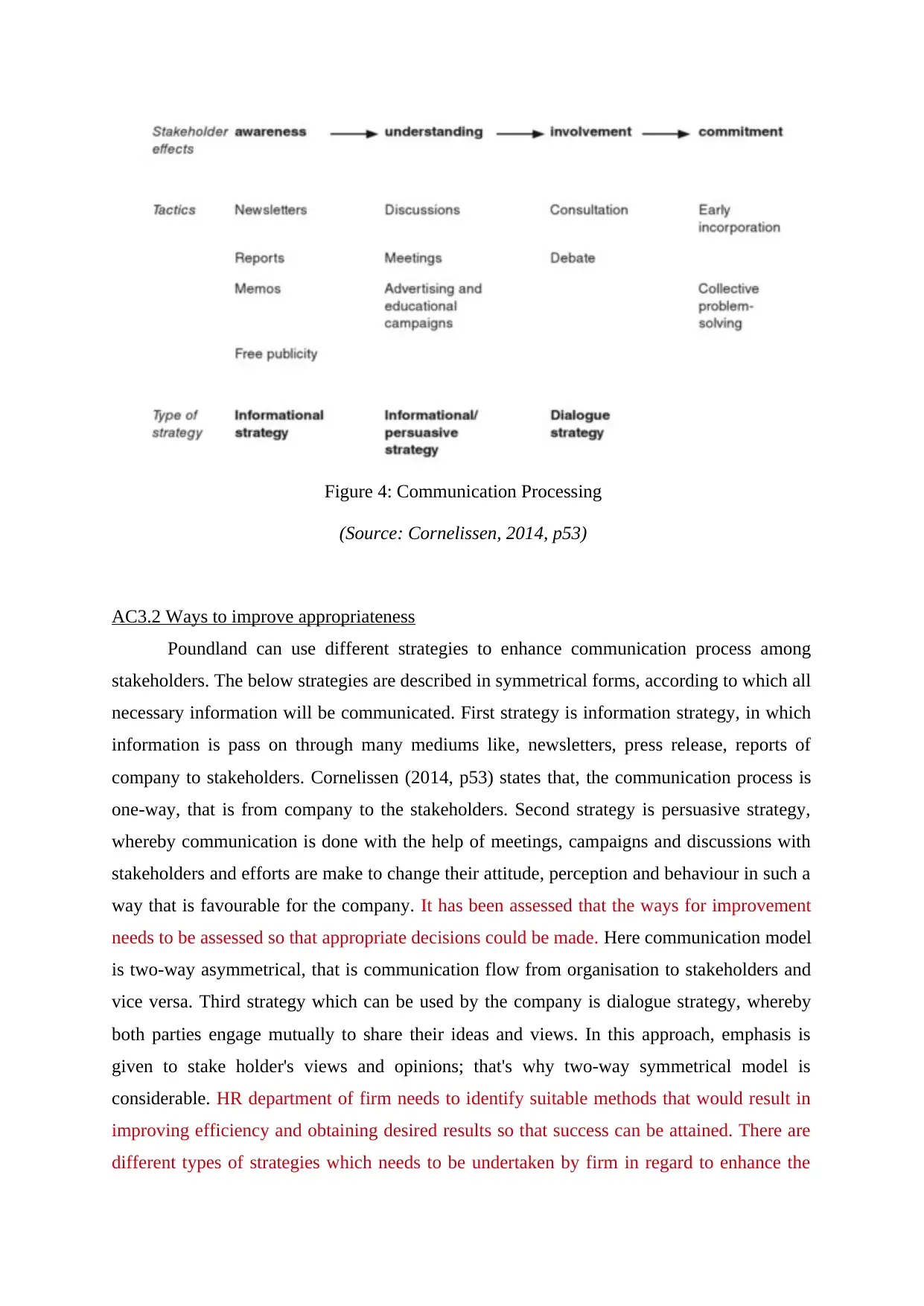
AC3.2 Ways to improve appropriateness
Poundland can use different strategies to enhance communication process among
stakeholders. The below strategies are described in symmetrical forms, according to which all
necessary information will be communicated. First strategy is information strategy, in which
information is pass on through many mediums like, newsletters, press release, reports of
company to stakeholders. Cornelissen (2014, p53) states that, the communication process is
one-way, that is from company to the stakeholders. Second strategy is persuasive strategy,
whereby communication is done with the help of meetings, campaigns and discussions with
stakeholders and efforts are make to change their attitude, perception and behaviour in such a
way that is favourable for the company. It has been assessed that the ways for improvement
needs to be assessed so that appropriate decisions could be made. Here communication model
is two-way asymmetrical, that is communication flow from organisation to stakeholders and
vice versa. Third strategy which can be used by the company is dialogue strategy, whereby
both parties engage mutually to share their ideas and views. In this approach, emphasis is
given to stake holder's views and opinions; that's why two-way symmetrical model is
considerable. HR department of firm needs to identify suitable methods that would result in
improving efficiency and obtaining desired results so that success can be attained. There are
different types of strategies which needs to be undertaken by firm in regard to enhance the
Figure 4: Communication Processing
(Source: Cornelissen, 2014, p53)
Poundland can use different strategies to enhance communication process among
stakeholders. The below strategies are described in symmetrical forms, according to which all
necessary information will be communicated. First strategy is information strategy, in which
information is pass on through many mediums like, newsletters, press release, reports of
company to stakeholders. Cornelissen (2014, p53) states that, the communication process is
one-way, that is from company to the stakeholders. Second strategy is persuasive strategy,
whereby communication is done with the help of meetings, campaigns and discussions with
stakeholders and efforts are make to change their attitude, perception and behaviour in such a
way that is favourable for the company. It has been assessed that the ways for improvement
needs to be assessed so that appropriate decisions could be made. Here communication model
is two-way asymmetrical, that is communication flow from organisation to stakeholders and
vice versa. Third strategy which can be used by the company is dialogue strategy, whereby
both parties engage mutually to share their ideas and views. In this approach, emphasis is
given to stake holder's views and opinions; that's why two-way symmetrical model is
considerable. HR department of firm needs to identify suitable methods that would result in
improving efficiency and obtaining desired results so that success can be attained. There are
different types of strategies which needs to be undertaken by firm in regard to enhance the
Figure 4: Communication Processing
(Source: Cornelissen, 2014, p53)
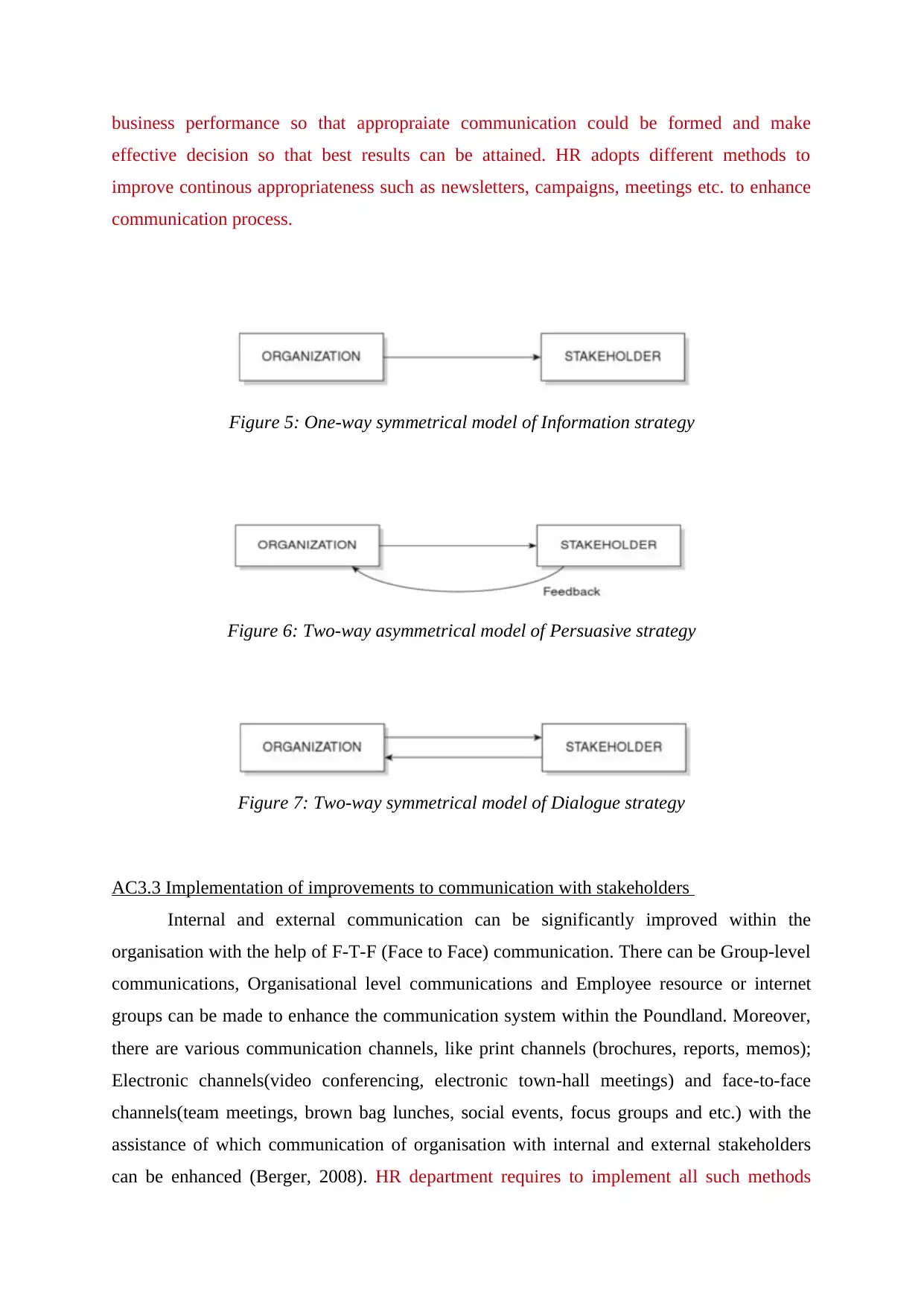
business performance so that appropraiate communication could be formed and make
effective decision so that best results can be attained. HR adopts different methods to
improve continous appropriateness such as newsletters, campaigns, meetings etc. to enhance
communication process.
AC3.3 Implementation of improvements to communication with stakeholders
Internal and external communication can be significantly improved within the
organisation with the help of F-T-F (Face to Face) communication. There can be Group-level
communications, Organisational level communications and Employee resource or internet
groups can be made to enhance the communication system within the Poundland. Moreover,
there are various communication channels, like print channels (brochures, reports, memos);
Electronic channels(video conferencing, electronic town-hall meetings) and face-to-face
channels(team meetings, brown bag lunches, social events, focus groups and etc.) with the
assistance of which communication of organisation with internal and external stakeholders
can be enhanced (Berger, 2008). HR department requires to implement all such methods
Figure 5: One-way symmetrical model of Information strategy
Source:
Figure 6: Two-way asymmetrical model of Persuasive strategy
Figure 7: Two-way symmetrical model of Dialogue strategy
effective decision so that best results can be attained. HR adopts different methods to
improve continous appropriateness such as newsletters, campaigns, meetings etc. to enhance
communication process.
AC3.3 Implementation of improvements to communication with stakeholders
Internal and external communication can be significantly improved within the
organisation with the help of F-T-F (Face to Face) communication. There can be Group-level
communications, Organisational level communications and Employee resource or internet
groups can be made to enhance the communication system within the Poundland. Moreover,
there are various communication channels, like print channels (brochures, reports, memos);
Electronic channels(video conferencing, electronic town-hall meetings) and face-to-face
channels(team meetings, brown bag lunches, social events, focus groups and etc.) with the
assistance of which communication of organisation with internal and external stakeholders
can be enhanced (Berger, 2008). HR department requires to implement all such methods
Figure 5: One-way symmetrical model of Information strategy
Source:
Figure 6: Two-way asymmetrical model of Persuasive strategy
Figure 7: Two-way symmetrical model of Dialogue strategy
⊘ This is a preview!⊘
Do you want full access?
Subscribe today to unlock all pages.

Trusted by 1+ million students worldwide
1 out of 20
Related Documents
Your All-in-One AI-Powered Toolkit for Academic Success.
+13062052269
info@desklib.com
Available 24*7 on WhatsApp / Email
![[object Object]](/_next/static/media/star-bottom.7253800d.svg)
Unlock your academic potential
Copyright © 2020–2025 A2Z Services. All Rights Reserved. Developed and managed by ZUCOL.





